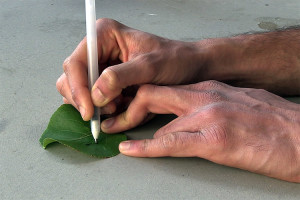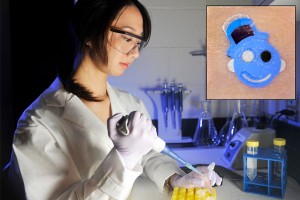The engineers at the University of California at San Diego (UCSD) are envisioning a future where anyone can create a biosensor anywhere. From a March 3, 2015 news item on Azonano,
A new simple tool developed by nanoengineers at the University of California, San Diego, is opening the door to an era when anyone will be able to build sensors, anywhere, including physicians in the clinic, patients in their home and soldiers in the field.
The team from the University of California, San Diego, developed high-tech bio-inks that react with several chemicals, including glucose. They filled off-the-shelf ballpoint pens with the inks and were able to draw sensors to measure glucose directly on the skin and sensors to measure pollution on leaves.
A March 2, 2015 UCSD news release by Ioana Patringenaru, which originated the news item, describes the researchers’ hopes for this technology,
Skin and leaves aren’t the only media on which the pens could be used. Researchers envision sensors drawn directly on smart phones for personalized and inexpensive health monitoring or on external building walls for monitoring of toxic gas pollutants. The sensors also could be used on the battlefield to detect explosives and nerve agents.
The team, led by Joseph Wang, the chairman of the Department of NanoEngineering at the University of California, San Diego, published their findings in the Feb. 26 [2015] issue of Advanced Healthcare Materials. Wang also directs the Center for Wearable Sensors at UC San Diego.
“Our new biocatalytic pen technology, based on novel enzymatic inks, holds considerable promise for a broad range of applications on site and in the field,” Wang said.
The news release goes on to describe one of the key concerns with developing the ink,
The biggest challenge the researchers faced was making inks from chemicals and biochemicals that aren’t harmful to humans or plants; could function as the sensors’ electrodes; and retain their properties over long periods in storage and in various conditions. Researchers turned to biocompatible polyethylene glycol, which is used in several drug delivery applications, as a binder. To make the inks conductive to electric current they used graphite powder. They also added chitosan, an antibacterial agent which is used in bandages to reduce bleeding, to make sure the ink adhered to any surfaces it was used on. The inks’ recipe also includes xylitol, a sugar substitute, which helps stabilize enzymes that react with several chemicals the do-it-yourself sensors are designed to monitor.
There’s a backstory to this research,
Wang’s team has been investigating how to make glucose testing for diabetics easier for several years. The same team of engineers recently developed non-invasive glucose sensors in the form of temporary tattoos. In this study, they used pens, loaded with an ink that reacts to glucose, to draw reusable glucose-measuring sensors on a pattern printed on a transparent, flexible material which includes an electrode. Researchers then pricked a subject’s finger and put the blood sample on the sensor. The enzymatic ink reacted with glucose and the electrode recorded the measurement, which was transmitted to a glucose-measuring device. Researchers then wiped the pattern clean and drew on it again to take another measurement after the subject had eaten.
Researchers estimate that one pen contains enough ink to draw the equivalent of 500 high-fidelity glucose sensor strips. Nanoengineers also demonstrated that the sensors could be drawn directly on the skin and that they could communicate with a Bluetooth-enabled electronic device that controls electrodes called a potentiostat, to gather data.
As mentioned earlier, there are more applications being considered (from the news release),
The pens would also allow users to draw sensors that detect pollutants and potentially harmful chemicals sensors on the spot. Researchers demonstrated that this was possible by drawing a sensor on a leaf with an ink loaded with enzymes that react with phenol, an industrial chemical, which can also be found in cosmetics, including sunscreen. The leaf was then dipped in a solution of water and phenol and the sensor was connected to a pollution detector. The sensors could be modified to react with many pollutants, including heavy metals or pesticides.
Next steps include connecting the sensors wirelessly to monitoring devices and investigating how the sensors perform in difficult conditions, including extreme temperatures, varying humidity and extended exposure to sunlight.
The researchers’ have provided a picture of the pen and a leaf,

Researchers drew sensors capable of detecting pollutants on a leaf. Courtesy: University of California at San Diego
Here’s a link to and a citation for the paper,
Biocompatible Enzymatic Roller Pens for Direct Writing of Biocatalytic Materials: “Do-it-Yourself” Electrochemical Biosensors by Amay J. Bandodkar, Wenzhao Jia, Julian Ramírez, and Joseph Wang. Advanced Healthcare Materials DOI: 10.1002/adhm.201400808 Article first published online: 26 FEB 2015
© 2015 WILEY-VCH Verlag GmbH & Co. KGaA, Weinheim
This article is behind a paywall.
